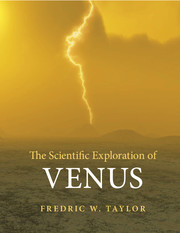Book contents
- Frontmatter
- Contents
- Overview
- Prologue
- A note on scientific units
- Acknowledgements
- Part I Views of Venus, from the beginning to the present day
- Part II The motivation to continue the quest
- Chapter 9 Origin and evolution
- Chapter 10 Atmosphere and ocean
- Chapter 11 A volcanic world
- Chapter 12 The mysterious clouds
- Chapter 13 Superwinds and polar vortices
- Chapter 14 The climate on Venus, past, present and future
- Chapter 15 Could there be life on Venus?
- Part III Plans and visions for the future
- Epilogue
- References and acknowledgements
- Appendix A Chronology of space missions to Venus
- Appendix B Data about Venus
- Index
- Plate section
- References
Chapter 10 - Atmosphere and ocean
from Part II - The motivation to continue the quest
Published online by Cambridge University Press: 05 September 2014
- Frontmatter
- Contents
- Overview
- Prologue
- A note on scientific units
- Acknowledgements
- Part I Views of Venus, from the beginning to the present day
- Part II The motivation to continue the quest
- Chapter 9 Origin and evolution
- Chapter 10 Atmosphere and ocean
- Chapter 11 A volcanic world
- Chapter 12 The mysterious clouds
- Chapter 13 Superwinds and polar vortices
- Chapter 14 The climate on Venus, past, present and future
- Chapter 15 Could there be life on Venus?
- Part III Plans and visions for the future
- Epilogue
- References and acknowledgements
- Appendix A Chronology of space missions to Venus
- Appendix B Data about Venus
- Index
- Plate section
- References
Summary
The pre-space age planetary astronomers knew that the albedo (reflectivity) of Venus is higher than that of Earth, which must partially offset the extra heating that comes from being closer to the Sun. It was widely expected that Venus would turn out to be a more tropical version of the Earth, but no one pictured a climate as extreme as the reality that was first detected by ground-based radio astronomers and confirmed by Mariner 2 and Venera 9. This was a big surprise at the time.
In fact, the modern value for the albedo, integrated over wavelength, is more than two and a half times that of Earth, at about 76 per cent rather than 30 per cent, so that Venus actually absorbs less radiative energy than Earth, despite the Sun appearing twice as large in the sky. Thus, it could be argued that Venus should be not warmer but actually cooler overall. This, however, does not take into account the huge difference in atmospheric thickness. On Venus the surface temperature enhancement through the blanketing ‘greenhouse’ effect is similar to, but more than ten times larger, than the corresponding effect on Earth.
- Type
- Chapter
- Information
- The Scientific Exploration of Venus , pp. 141 - 155Publisher: Cambridge University PressPrint publication year: 2014



